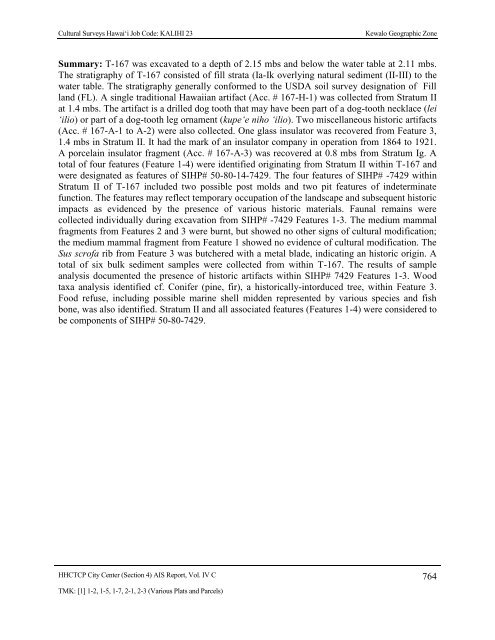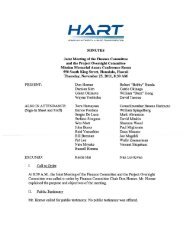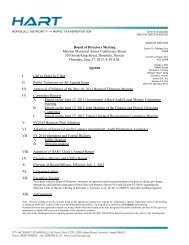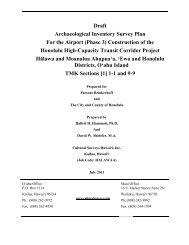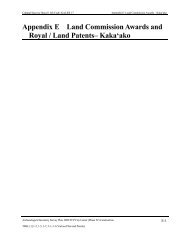4.12 Test Excavation 167 (T-167) - Honolulu Rail Transit Project
4.12 Test Excavation 167 (T-167) - Honolulu Rail Transit Project
4.12 Test Excavation 167 (T-167) - Honolulu Rail Transit Project
Create successful ePaper yourself
Turn your PDF publications into a flip-book with our unique Google optimized e-Paper software.
Cultural Surveys Hawai‘i Job Code: KALIHI 23Kewalo Geographic ZoneSummary: T-<strong>167</strong> was excavated to a depth of 2.15 mbs and below the water table at 2.11 mbs.The stratigraphy of T-<strong>167</strong> consisted of fill strata (Ia-Ik overlying natural sediment (II-III) to thewater table. The stratigraphy generally conformed to the USDA soil survey designation of Fillland (FL). A single traditional Hawaiian artifact (Acc. # <strong>167</strong>-H-1) was collected from Stratum IIat 1.4 mbs. The artifact is a drilled dog tooth that may have been part of a dog-tooth necklace (lei‘ilio) or part of a dog-tooth leg ornament (kupe‘e niho ‘ilio). Two miscellaneous historic artifacts(Acc. # <strong>167</strong>-A-1 to A-2) were also collected. One glass insulator was recovered from Feature 3,1.4 mbs in Stratum II. It had the mark of an insulator company in operation from 1864 to 1921.A porcelain insulator fragment (Acc. # <strong>167</strong>-A-3) was recovered at 0.8 mbs from Stratum Ig. Atotal of four features (Feature 1-4) were identified originating from Stratum II within T-<strong>167</strong> andwere designated as features of SIHP# 50-80-14-7429. The four features of SIHP# -7429 withinStratum II of T-<strong>167</strong> included two possible post molds and two pit features of indeterminatefunction. The features may reflect temporary occupation of the landscape and subsequent historicimpacts as evidenced by the presence of various historic materials. Faunal remains werecollected individually during excavation from SIHP# -7429 Features 1-3. The medium mammalfragments from Features 2 and 3 were burnt, but showed no other signs of cultural modification;the medium mammal fragment from Feature 1 showed no evidence of cultural modification. TheSus scrofa rib from Feature 3 was butchered with a metal blade, indicating an historic origin. Atotal of six bulk sediment samples were collected from within T-<strong>167</strong>. The results of sampleanalysis documented the presence of historic artifacts within SIHP# 7429 Features 1-3. Woodtaxa analysis identified cf. Conifer (pine, fir), a historically-intorduced tree, within Feature 3.Food refuse, including possible marine shell midden represented by various species and fishbone, was also identified. Stratum II and all associated features (Features 1-4) were considered tobe components of SIHP# 50-80-7429.HHCTCP City Center (Section 4) AIS Report, Vol. IV C 764TMK: [1] 1-2, 1-5, 1-7, 2-1, 2-3 (Various Plats and Parcels)


